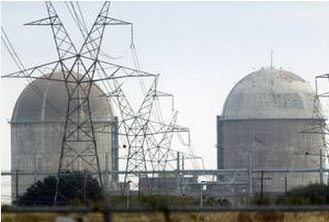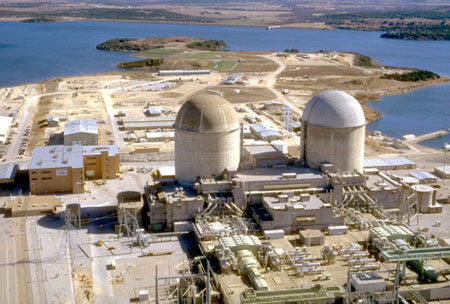Archive for the ‘Nukes’ Category
CB&I to cut more than 300 jobs after contract ends
Apr 28, 2015
Olivia Pulsinelli
Houston Business Journal

Mike Fuentes/Bloomberg News
Dallas-based Luminant told CB&I Stone & Webster Inc. last week that it would discontinue the teaming agreement the companies have for the Comanche Peak Nuclear Power Plant in Glen Rose, Texas. CB&I will cut 322 jobs at that location.
The Netherlands-based Chicago Bridge & Iron Company NV (NYSE: CBI), which has its operational headquarters in The Woodlands, will cut 322 jobs in Texas, according to a letter to the Texas Workforce Commission.
Dallas-based Luminant told CB&I Stone & Webster Inc. last week that it would discontinue the teaming agreement the companies have for Luminant’s Comanche Peak Nuclear Power Plant. The plant is in Glen Rose, about 55 miles southwest of Fort Worth.
Luminant has asked CB&I Stone & Webster to assist with transition services through May 31, which is when CB&I expects to terminate the positions. Stone & Webster, which was founded in 1889, became part of The Shaw Group in 2000. CB&I acquired Shaw in 2013.
This document contains copyrighted material whose use has not been specifically authorized by the copyright owner. SEED Coalition is making this article available in our efforts to advance understanding of ecological sustainability, human rights, economic democracy and social justice issues. We believe that this constitutes a "fair use" of the copyrighted material as provided for in section 107 of the US Copyright Law. If you wish to use this copyrighted material for purposes of your own that go beyond "fair use", you must obtain permission from the copyright owner.
NRC increases oversight of Comanche Peak nuclear power plant
April 29, 2015
Source: U.S. Nuclear Regulatory Commission
Via PennEnergy

NRC finalizes security-related inspection finding for Comanche Peak nuclear power plant, resulting in additional oversight
The Nuclear Regulatory Commission (NRC) will increase its level of oversight at the Comanche Peak nuclear power plant following the finalization of a security-related inspection finding classified as "greater than green." Luminant Generation Co. owns the plant, which has two operating reactors and is located near Glen Rose, Texas.
The NRC uses a color-coded assessment system for inspection findings and performance indicators, with colors ranging from green, for very low safety or security significance, to white, yellow or red, connoting high safety or security significance. In the case of security-related inspection findings or performance indicators, the NRC notifies the public when the "greater than green" threshold has been crossed. However, the agency does not provide specifics because of the sensitive nature of the information associated with such findings and indicators.
NRC inspectors identified the finding during a security baseline inspection at the Comanche Peak plant that concluded on January 26, 2015. On April 2, Luminant Generation Company provided the NRC a letter that described the reason for the violation and the corrective actions taken. The finding was documented in an inspection report issued on March 6, 2015.
After considering the information presented by the company, and the information developed during the inspection, the NRC has determined the finding is appropriately characterized as "greater than green."
"The NRC will determine the most appropriate response with respect to inspection and follow-up reviews, based on the significance of the finding," NRC Region IV Administrator Marc Dapas said. "It should be noted that the plant remains secure. Before our inspectors left the site, we ensured that appropriate compensatory measures were implemented."
This document contains copyrighted material whose use has not been specifically authorized by the copyright owner. SEED Coalition is making this article available in our efforts to advance understanding of ecological sustainability, human rights, economic democracy and social justice issues. We believe that this constitutes a "fair use" of the copyrighted material as provided for in section 107 of the US Copyright Law. If you wish to use this copyrighted material for purposes of your own that go beyond "fair use", you must obtain permission from the copyright owner.
Andrews County Considering Proposal to Store ‘High-Level Nuclear Waste’
Dec 01, 2014
By: Julia Deng
NewsWest 9
![]()
Listen to news story on NewsWest 9’s site
 ANDREWS – Legislators, nuclear waste specialists and more than 400 Andrews County residents gathered Monday night to discuss the possibility of storing high-level nuclear waste at a facility approximately 25 miles west of Downtown Andrews.
ANDREWS – Legislators, nuclear waste specialists and more than 400 Andrews County residents gathered Monday night to discuss the possibility of storing high-level nuclear waste at a facility approximately 25 miles west of Downtown Andrews.
Waste Control Specialists (WCS) operates the radioactive waste site and is responsible for the low-level nuclear material already being treated, stored and disposed of in Andrews County.
"Fees for low-level waste have produced about $3 million for Andrews County over the last year," said Rod Baltzer, President of WCS.
"For low-level waste, Andrews County gets five percent of our gross revenue for everything we dispose of."
He estimated high-level nuclear waste storage, if approved by community members and legislators, would generate $10 million annually.
Low-level nuclear waste consists primarily of contaminated clothing, work gloves and other site equipment, while high-level nuclear waste would be spent nuclear fuel rods.
The rods, or "fuel pins," are long metal tubes that uranium oxide pellets or other uranium-based materials are sealed into before being placed in a nuclear reactor.
Safe treatment and storage of the spent rods would occur in 60- to 100-year cycles at the Andrews facility.
"If Andrews County and the community does not want this, it will not happen," said Baltzer.
Community concerns include "radioactive exposure, accidents and things like that," according to Senator Kel Seliger, who oversaw much of the legislation for WCS’s low-level nuclear waste storage.
County-wide benefits, on the other hand, would include "cash flow and more jobs," he said.
Sen. Seliger encouraged community members at Monday night’s meeting to "think carefully about all those factors" because the "decision will be made by [them]."
WCS officials said they have not filed licensing applications or taken other legislative action yet, and do not plan to do so until evaluating community reaction.
The licensing process, expected to take three to five years, would be followed by at least another year of construction and facility preparation.
High-level nuclear waste would not be transported to Andrews County until 2020 at the earliest.
"We will have open forums for community members to voice their opinions before we go ahead [with this storage proposal]," said Baltzer.
"Anybody with questions or concerns can also submit them on our website, WCSTexas.com."
This document contains copyrighted material whose use has not been specifically authorized by the copyright owner. SEED Coalition is making this article available in our efforts to advance understanding of ecological sustainability, human rights, economic democracy and social justice issues. We believe that this constitutes a "fair use" of the copyrighted material as provided for in section 107 of the US Copyright Law. If you wish to use this copyrighted material for purposes of your own that go beyond "fair use", you must obtain permission from the copyright owner.
Boxer: Nuclear regulators haven’t learned from Fukushima
12/03/14
By Timothy Cama
The Hill
Sen. Barbara Boxer (D-Calif.) accused the body responsible for nuclear energy safety of ignoring recommendations that sprung from 2011’s Fukushima Dai-ichi nuclear meltdown.
In the 10th hearing she has held on the disaster caused by an earthquake and tsunami, Boxer, chairwoman of the Environment and Public Works Committee, said regulators have not acted on any of the recommendations made after the disaster.
"The reality is that not a single one of the 12 key safety recommendations made by the Fukushima Near-Term Task Force has been implemented," Boxer told the five members of the Nuclear Regulatory Commission (NRC).
"There isn’t one of these that’s in place, not a single one," she said as an aide held a chart of the recommendations behind her.
Senior staffers and engineers at NRC made the recommendations months Fukushima in an effort to reduce the chances of a similar meltdown at nuclear power plants in the United States, or to mitigate its effects if it did happen.
Staffers told regulators to ensure that nuclear plants reevaluate flooding and seismic risks, improve staffing and communications for evacuation procedures, take steps to mitigate blackout effects, and other tasks.
NRC commissioners defended their actions over the last three years.
"The NRC continues to make significant progress in implementing post-Fukushima safety enhancements," said Allison MacFarlane, the commission’s chairwoman, who will step down soon.
She said plants are already starting to comply with other priorities from the task force, such as making improvements to the pools where they store spent fuel, installing diesel backup generators, and ensuring that all emergency equipment can be quickly and easily deployed.
"As a result of these activities, nuclear power plants in the United States will have more defense and depth to cope with long losses of offsite power and other severe accident conditions," she said.
Her fellow commissioners agreed.
"I’m very proud of the actions that we’ve required as an agency," said Commissioner William Ostendorf. "I believe that we take a thoughtful approach based in science, engineering and best principals to ensure that the right things are being done in the proper sequence."
Commissioner Kristine Svinicki agreed with MacFarlane and highlighted improvements to emergency equipment.
But Boxer wasn’t pleased.
"How can you say you’re proud of what you did?" she challenged MacFarlane. "I know you did a lot of other things that are good, but how you can say you’re proud that you helped us post-Fukushima, that’s beyond my ability to understand."
Boxer brought Rep. Lois Capps (Calif.), whose district includes California’s only operating nuclear plant, to back up her case.
"That tragedy put in such stark terms how little we actually knew about the seismic situation at Diablo Canyon and the potential consequences," she said.
This document contains copyrighted material whose use has not been specifically authorized by the copyright owner. SEED Coalition is making this article available in our efforts to advance understanding of ecological sustainability, human rights, economic democracy and social justice issues. We believe that this constitutes a "fair use" of the copyrighted material as provided for in section 107 of the US Copyright Law. If you wish to use this copyrighted material for purposes of your own that go beyond "fair use", you must obtain permission from the copyright owner.
Sampling detects contamination at WIPP
November 6, 2014
By The Associated Press
CARLSBAD, N.M. (AP) – A pair of air samplers at the nation’s only underground nuclear waste repository detected low levels of radioactive contamination after workers restarted one of the fans at the facility in southeastern New Mexico, officials said Thursday.
They confirmed the contamination was well below levels that would affect the environment or workers at the Waste Isolation Pilot Plant.
"At no time were employees, the public or the environment at risk," the U.S. Department of Energy’s Carlsbad Field Office said in a statement.
The fan, which is part of the underground ventilation and filtration system, was restarted in late October as part of the lengthy process of bringing the plant back online after a canister of waste from Los Alamos National Laboratory leaked inside a storage room.
That radiological release in February contaminated 22 workers and forced closure of the plant.
Officials had expected some residual contamination in the adjacent ductwork and interior workings of the fan since it was running for two months following the incident.
As a precaution, workers took shelter inside buildings before restarting the fan last month and stayed in place for 30 minutes until it was determined to be safe.
Slightly elevated levels of airborne contamination were identified at an air sampler located at the end of the exhaust duct where filtered air exits the underground facility. Contamination was also detected by a second sampler about 60 yards away from the fan.
Officials said the results for the remaining samplers were either below the minimum detectable concentration or within the range normally observed at the site.
The Carlsbad Field Office said it would continue to monitor the air samplers to ensure there are no changes in the readings.
This document contains copyrighted material whose use has not been specifically authorized by the copyright owner. SEED Coalition is making this article available in our efforts to advance understanding of ecological sustainability, human rights, economic democracy and social justice issues. We believe that this constitutes a "fair use" of the copyrighted material as provided for in section 107 of the US Copyright Law. If you wish to use this copyrighted material for purposes of your own that go beyond "fair use", you must obtain permission from the copyright owner.


